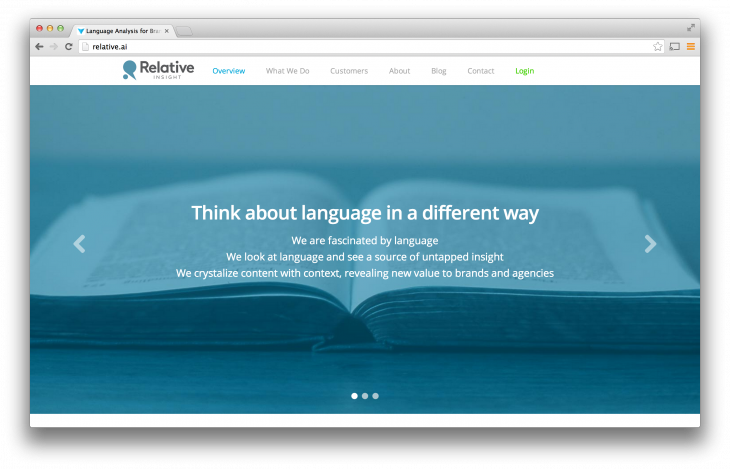
The power of modern language analysis techniques in better understanding the world around us is as yet largely untapped. One company looking to change that is UK-based Relative Insight.
Working with brands and marketing agencies, Relative Insight “turns language into data,” as CMO Rich Wilson puts it. It’s an approach that has attracted early customers that include Microsoft and Ogilvy.
Using its service, a brand can compare how the language in its own marketing materials compares to that of competitors, or that of potential customers. So, Wilson says, banks use it to compare how their language use differs from consumer-friendly brands like Virgin Media or EasyJet. One supermarket used it to see how its customers talked about summer, to ensure that its advertising related well to the target market.
The company’s technology is based on 10 years of language analysis research at Lancaster University, mainly looking at the language used by criminals. It’s no surprise, then, that the first commercial application of the research was in law enforcement. We covered Relative Insight when it was known as Isis Forensics, focusing on detecting pedophiles pretending to be children on social media. A rebrand later, and the company continues that work but has expanded into the marketing world.
How it works
Relative Insight takes two datasets (say, some marketing copy for a product and a bunch of online forum posts by people who may buy the product) and compares them. Wilson says that while basic language comparison has been used in marketing in the past, there has never been the ability to directly compare against rivals or target audiences.
In the supermarket example mentioned above, the company scooped up one million words from parenting forums Mumsnet and Netmums. Forums and review sites are good sources of data, Wilson says; “people tend to talk openly and in a structured way about their behavior and beliefs.
“On Mumsnet, they talk about… visiting stately homes, putting up wigwams in garden, going on holidays – it’s about doing things. On Netmums, it’s more about children and family and how much things cost… This can inform campaigns – targeting a Netmums audience requires different language to Mumsnet.”
In addition to helping prepare a campaign, it can also be used to better understand why a campaign succeeded or failed. For brands it can be a “stick to beat up their agency with,” as Wilson puts it. For example, if you compare advertising for luxury brands, their use of language tends to be identical except for the brand name itself, Wilson says. If you’re the incumbent agency, you may see this as evidence that you did your job well by matching up to competitors. The brand, or a rival agency bidding for the account, may see it the other way – as an opportunity to do something new and that will stand out.
Relative Insight originally set up its marketing-focused product as a SaaS-based self-service dashboard, but found that no-one within brands or agencies knew how to work with it – these companies don’t hire language analysts. That means that for now the company is offering a managed service where it provides a lot more assistance to clients. The plan remains to move back to a SaaS offering as the market evolves.
Don’t miss: How to measure customer loyalty effectively
Image credit: Shutterstock
Get the TNW newsletter
Get the most important tech news in your inbox each week.






